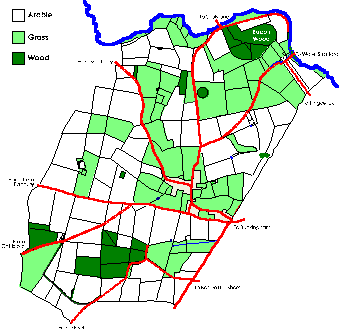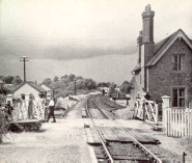
Finmere in Early Victorian Times
Newsletter 10: March 1998
A Self-Sufficient Era
Finmere is now largely a ‘dormitory village’ and the majority of residents work elsewhere. A century and a half ago, most men worked on the land. Village tradesmen and women supplied their daily needs. Many other women also toiled to make lace. In this newsletter, we look at the village life in Finmere in the 1840s and 1850s.
A Changing World
In 1840, Britain was coming to the end of the industrial revolution. During the previous century, Britain’s largely rural society — in which most livelihoods were based on the land — had been transformed. It was now a rapidly urbanising nation and wealth increasingly came from commerce and manufacturing. Victoria had been on the throne for three years and that year married Prince Albert.
The population of Britain grew from 18.5 million in 1841 to 20.8 million in 1851 and people continued to move from the countryside to towns. By the end of the 1840s, the second burst of railway mania was over and Britain had nearly six thousand miles of railways. These changes, however, had only a passing effect on life in Finmere.
The 1840 Tithe Map
The tithe was a tenth of the produce from the land and was paid by landholders and tenants to the Church. In medieval times the tithe was paid in kind. But assessment, collection, storage and disposal of tithe goods became increasingly impractical. From the seventeenth century, parishes commuted their tithes into more convenient rent payments. In 1836, Parliament passed The Commutation Act, which ordered the universal replacement of tithes by rent charges.
On the eighteenth of March 1840, Robert Russel, a valuer from Brackley, began a survey of Finmere parish and a series of meetings with landowners and tenants. On the last day of August, agreement was reached:
The annual sum of four Hundred and Fifty Seven Pounds … shall be payable and paid to the said William Jocelyn Palmer as Rector…
After approval of the agreement by the Tithe Commissioners, Finmere tithes were paid as rents. In pursuing this agreement, Russel produced two documents of major importance to our research into Finmere’s history.
A Map of Value
The first document was a map of the parish and its fields.

Many of these fields can been seen on the modern map but other field boundaries have changed as fields have been amalgamated. Bacon Wood in the north of the parish has been cleared. The map also shows tracks to Shalstone, Cottisford and Newton Purcell that now survive only as footpaths.
The second document was an ‘award’: an inventory of landowners, tenants, land use and field names. It is a unique record of Finmere and reveals the dominance of the Duke of Buckingham in 1840:
Most parishioners were tenants, working on land rented from the Duke and living in village cottages rented from the Duke or the Rector.
Six years after the tithe map was compiled, the North-Western Railway from Brackley to Buckingham was constructed across the north part of the parish. There was a halt, which still survives, at Fulwell (pictured overleaf). The second railway, the Great Central, and Finmere Station were not built until 1899.

Fulwell Halt on the North-Western Railway
An Unchanged Life
Despite the coming of the railway and the growth of nearby towns, Finmere changed little during the 1840s. We are fortunate to have a description of the village in the early 1850s. Dean Burgon of Chichester, a former curate of Finmere, wrote this rose-tinted memoir in the 1880s.
The village was both picturesque and interesting. Humble as the cottages were, few, if any, were dilapidated. There was an air of cleanliness, of decency, even of comfort, about the place and about the people. Squalid poverty there was none. The peasantry behaved respectfully to strangers. The Church, however unattractive æsthetically, was fully adequate to the requirements of the parish, and was filled twice every Sunday with a truly devout and attentive congregation…
Poverty, however, remained a significant problem in Finmere (Newsletter 2) and was to some extent alleviated by William Jocelyn Palmer, the Rector.
Parishioners who subscribed during the summer at four stated periods, were entitled to a ton or half-a-ton of coal, according to their subscription [to the Rector], for their winter supply, at 3s less per ton than the cost price. The farmers kindly carried the coal for them. Poor and destitute widows received as a benefaction five cwt. twice in the course of the winter.
About 1000 fagots of underwood or peeled oak-tops were bought annually, in the spring of the year, for next year’s consumption. These were carried round and sold to the poor at the cost price, being delivered at their doors at the Rector’s expense, and paid for on delivery. Five fagots were obtainable for one shilling. It was a frequent remark of [the Rector’s] — “No greater charity can be done for the poor than to help them towards getting fuel. They must have it; and if they cannot get it, they will take it.”
Burgon’s description of the village is taken from Blomfield’s 1886 History of Finmere. We have received an excellent response to our pre-publication offer for a new edition of the book and copies will be delivered in May. It is not too late to subscribe at just £5 a copy. Please contact Carol Cranfield at Furthering Hobbs on 01280 847056 in the next few days.
The 1851 Census
The first full census of Finmere was conducted in 1851 and provides information on the poor villagers that were described in Burgon’s memoir. There were then 391 people living in the parish. Two-thirds of the adult men and one-third of the women were born here.
The parish had five farmers:
A cattle dealer, Richard Lepper lived in the village at Lepper’s House (see Newsletter 7). Eighty-four men (two-thirds) laboured on the land, including two shepherds (James Measey at Finmere Grounds and his brother John at Bacon’s House). Other men were employed in a variety of occupations:
Only three men were described as paupers compared to twenty-one women. Thirty-three women were in work including sixteen lacemakers, eleven in service and three assistants to the doctors at Finmere House.
A Changed Village
At the last census in 1991, Finmere had just 364 people. Most workers were in the manufacturing, construction, catering, distribution and financial industries. Few worked on the land. Poverty had declined and nearly three-quarters owned their houses. Just 13% worked at home and 6% walked to work. But for all these changes, the village remains “picturesque and interesting” and would surely still be recognised by Dean Burgon.